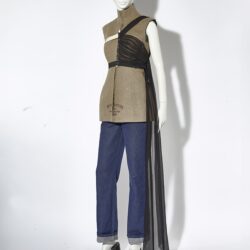Between heat and nudity in the Middle Ages

When summer reaches peak temperatures, our dear bodies as well. We grab our shorts, skirts and tank tops, and look for the lightest existing fabric. But in the Middle Ages — a time period approximately framed between 500 A.D. and 1493 —, religious powers at play fueled a more and more private and intimate relationship to nudity. Hence, at a time when nudity rimed with sin and shame, how did people cope with summer heat? Focusing on European main trends of the 12th, 13th and 14th centuries, let's have a look at several medieval tips and tricks to deal with heat and avoid sunburns.

When polyester was not an option...
Medieval fashion consisted of a complexe layering of fabrics and clothes. Surcoats covered tunics that covered undergarments. In the context of a highly hierarchical society — often based on a feudal system —, shapes didn't differ much from class to class: it was the materials that identified social distinctions. And while fashion trends are often reflections of the technical facilities and knowledge of their time, medieval fashion was marked by a wide use of natural fibers such as linen, hemp, wool, animal skins, and more rarely silk, velvet and lace. Cotton, for example, had not yet invaded the continent, and when imported, was reserved to a privileged population. But actually, those natural substances had the advantage of keeping bodies warm in winter and cool in summer — when woven into a very thin and light cloth.
...natural layers and layers were.
In case of high heat, people would play with this specific layering of fabrics. Pins and brooches sculpted draperies, and women would hitch their tunics up and tuck the fabric under their belt. As for men, they would wear shorter tunics: underclothes were revealed but flesh was kept secret. However, when pieces of cloth could not be taken off and when only natural fibres were to be used, accessories also complemented this layered outfit to challenge their inherent warmth.
From head to toe...

In those days, for every stratum of the population, it was common to cover one’s head. Whether it was in summer or in winter, all types of headdress served as protection against meteorological hindrances, but also once more, as a marker of social status. On the one hand, noblewomen would wear veils or wimples — large pieces of silk or linen, draped around the head, the neck and the chin. Their size and shape varied across the centuries, and their use ranged from practical to symbolic. Wimples would prevent sunburns and ensure a highly valued pale complexion. On the other hand, straw hats were reserved to peasants — both men and women — to cover their head and face while working. And it is only from the XVIth century in Italy, that straw hats gave way to designer’s creations and infused aristocratic trends.

...to their fingertips.
Fans were also commonly used to chase away heat, especially in the southern lands of what we call Europe today. In the early Middle Ages, flabella were used for liturgical ceremonies, and their secular use dates back from the XIIIth century. Results of early cultural exchanges with Asian empires — whether it was through Crusades or merchants — fans were promptly appropriated by aristocratic classes. Hints of their presence pepper medieval paintings.


That said, and weaving being fastidious in those days, medieval clothing was known for its practicality and longevity. Indeed, pieces were worn till their fibers would break and till their consistency would disappear. Middle Ages’ clothes were to be kept until unusable, and gradually paved the way to the eccentric fashion items of the Renaissance period. And their quality clearly defies today’s fast fashion and the hegemonial use of synthetic fibers. Thus, this perspective draws the contour of a very distinctive relationship to garments, and offers an alternative look to our contemporary ways to cope with the summer heat — that doesn't resume itself to reveal one's flesh. But what will happen to the conceptions of fashion and nudity in the context of an ever rising global temperature?




